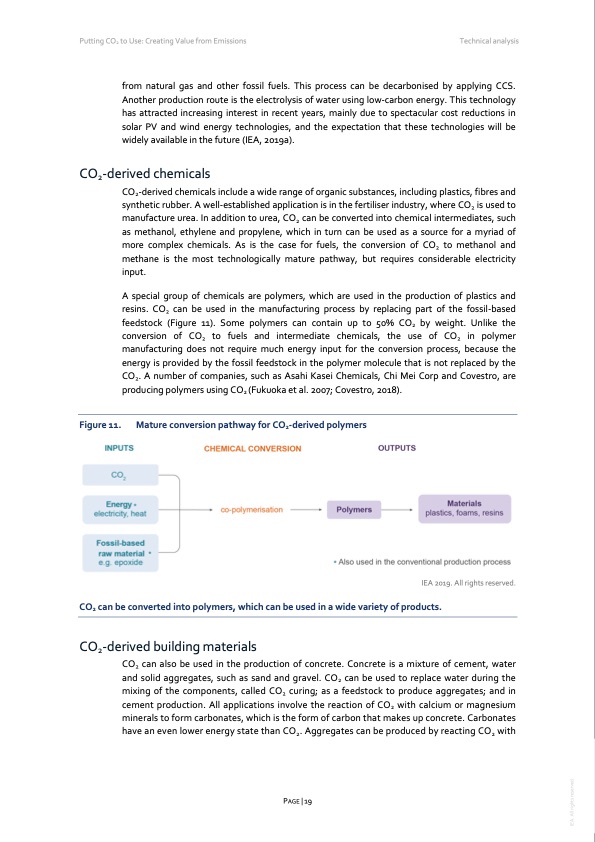
PDF Publication Title:
Text from PDF Page: 020
Putting CO2 to Use: Creating Value from Emissions Technical analysis from natural gas and other fossil fuels. This process can be decarbonised by applying CCS. Another production route is the electrolysis of water using low-carbon energy. This technology has attracted increasing interest in recent years, mainly due to spectacular cost reductions in solar PV and wind energy technologies, and the expectation that these technologies will be widely available in the future (IEA, 2019a). CO2-derived chemicals CO2-derived chemicals include a wide range of organic substances, including plastics, fibres and synthetic rubber. A well-established application is in the fertiliser industry, where CO2 is used to manufacture urea. In addition to urea, CO2 can be converted into chemical intermediates, such as methanol, ethylene and propylene, which in turn can be used as a source for a myriad of more complex chemicals. As is the case for fuels, the conversion of CO2 to methanol and methane is the most technologically mature pathway, but requires considerable electricity input. A special group of chemicals are polymers, which are used in the production of plastics and resins. CO2 can be used in the manufacturing process by replacing part of the fossil-based feedstock (Figure 11). Some polymers can contain up to 50% CO2 by weight. Unlike the conversion of CO2 to fuels and intermediate chemicals, the use of CO2 in polymer manufacturing does not require much energy input for the conversion process, because the energy is provided by the fossil feedstock in the polymer molecule that is not replaced by the CO2. A number of companies, such as Asahi Kasei Chemicals, Chi Mei Corp and Covestro, are producing polymers using CO2 (Fukuoka et al. 2007; Covestro, 2018). Mature conversion pathway for CO2-derived polymers IEA 2019. All rights reserved. CO2 can be converted into polymers, which can be used in a wide variety of products. CO2-derived building materials CO2 can also be used in the production of concrete. Concrete is a mixture of cement, water and solid aggregates, such as sand and gravel. CO2 can be used to replace water during the mixing of the components, called CO2 curing; as a feedstock to produce aggregates; and in cement production. All applications involve the reaction of CO2 with calcium or magnesium minerals to form carbonates, which is the form of carbon that makes up concrete. Carbonates have an even lower energy state than CO2. Aggregates can be produced by reacting CO2 with Figure 11. PAGE | 19 IEA. All rights reserved.PDF Image | Putting CO2 to Use Creating value from emissions

PDF Search Title:
Putting CO2 to Use Creating value from emissionsOriginal File Name Searched:
putting_co2_to_use.pdfDIY PDF Search: Google It | Yahoo | Bing
NFT (Non Fungible Token): Buy our tech, design, development or system NFT and become part of our tech NFT network... More Info
IT XR Project Redstone NFT Available for Sale: NFT for high tech turbine design with one part 3D printed counter-rotating energy turbine. Be part of the future with this NFT. Can be bought and sold but only one design NFT exists. Royalties go to the developer (Infinity) to keep enhancing design and applications... More Info
Infinity Turbine IT XR Project Redstone Design: NFT for sale... NFT for high tech turbine design with one part 3D printed counter-rotating energy turbine. Includes all rights to this turbine design, including license for Fluid Handling Block I and II for the turbine assembly and housing. The NFT includes the blueprints (cad/cam), revenue streams, and all future development of the IT XR Project Redstone... More Info
Infinity Turbine ROT Radial Outflow Turbine 24 Design and Worldwide Rights: NFT for sale... NFT for the ROT 24 energy turbine. Be part of the future with this NFT. This design can be bought and sold but only one design NFT exists. You may manufacture the unit, or get the revenues from its sale from Infinity Turbine. Royalties go to the developer (Infinity) to keep enhancing design and applications... More Info
Infinity Supercritical CO2 10 Liter Extractor Design and Worldwide Rights: The Infinity Supercritical 10L CO2 extractor is for botanical oil extraction, which is rich in terpenes and can produce shelf ready full spectrum oil. With over 5 years of development, this industry leader mature extractor machine has been sold since 2015 and is part of many profitable businesses. The process can also be used for electrowinning, e-waste recycling, and lithium battery recycling, gold mining electronic wastes, precious metals. CO2 can also be used in a reverse fuel cell with nafion to make a gas-to-liquids fuel, such as methanol, ethanol and butanol or ethylene. Supercritical CO2 has also been used for treating nafion to make it more effective catalyst. This NFT is for the purchase of worldwide rights which includes the design. More Info
NFT (Non Fungible Token): Buy our tech, design, development or system NFT and become part of our tech NFT network... More Info
Infinity Turbine Products: Special for this month, any plans are $10,000 for complete Cad/Cam blueprints. License is for one build. Try before you buy a production license. May pay by Bitcoin or other Crypto. Products Page... More Info
| CONTACT TEL: 608-238-6001 Email: greg@infinityturbine.com | RSS | AMP |